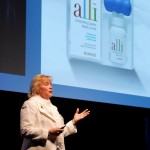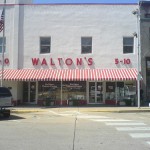May11
Andrea Meyer
Point: Products that perform a rational purpose can fail if they don’t address emotional needs
Story: At the World Innovation Forum, Donna Sturgess, Global Head of Innovation at GlaxoSmithKline Consumer Healthcare, described some of the innovations behind Alli, an over-the-counter weight-loss drug which can help people lose 50% more weight. As I see it, the heart of the innovation lies beyond the physical chemistry of the medication (which blocks the absorption of fat) because the medication does no good if it’s not taken at mealtime. Instead, the real innovation is in the emotional chemistry of the small blue pill carrier called the Shuttle, which encourages the person to stay on their diet.
Alli faces two significant challenges. First, the pharmaceutical performance of a medication means nothing if patients don’t take the drug. Compliance could be a issue with Alli because it needs to be taken with meals, including meals eaten outside the home. That means people need to carry their pills with them.
Second, dieting comes with strong emotional issues. Dieters run a gauntlet of body self-image issues, willpower, fear of failure, and cravings as they attempt to achieve their goals. Sturgess cited data that emotional issues affect 85% of all decisions. Products that perform a rational purpose can fail if they don’t address emotional needs and wants.
To provide emotional support, GlaxoSmithKline designed the Shuttle to be both discrete and distinctive. The calming blue pill carrier looks like a contact lens case. The linear-arrangement of three smooth lobes fits comfortably in the hand. GlaxoSmithKline gave the Shuttle a smooth texture, like a worry-stone. The company intentionally left off any brand markings or names to avoid customer embarrassment — only fellow Alli users know what the little blue case means. The point is that the Shuttle is more than just a functional accessory: it’s a emotional talisman to support dieting.
Action
- Consider the emotional experiences, contexts, and meaning of the product and the product’s use.
- Create product artifacts or accessories that support those emotional experiences.
- Use non-functional product attributes (e.g., color, shape, and surface texture) to convey emotion.
Photo courtesy of Dov Friedmann – PhotographybyDov.com
Case study, How-to, Innovation, New Product Development, Strategy
May06
Andrea Meyer
Point: Merging functionality can create innovations in efficiency and convenience
Story: As someone who spends more than my fair share of time in airports, I’ve wondered if passengers don’t deserve frequent flier miles for distances walked all over the terminal buildings. The food court is one place, the gate is in another, and finding a power outlet to recharge the laptop for the long flight home is always a challenge. In most airports, no single location suffices for all these purposes. When sitting at the gate, one doesn’t know if one has time to go grab a bite to eat. And when sitting at the restaurant, one doesn’t know if one’s flight is about to board.
OTG tackled this problem when they designed the airport experience for JetBLue’s new T5 terminal at JFK airport. OTG created a new mixed-use approach for some of the gate space. About half the 26 gates have special 16-seat clusters called “re:vive” that lets passengers eat, recharge, and keep an eye on their flight. Touchscreen monitors and credit card readers let passengers order, pay for, and have food delivered right to the gate. The ordering process even provides a delivery time estimate before a passenger gives the final “OK” for the order.
“Re:vive” is more than just a passenger convenience. It also boosts revenues for food concessionaires by reaching the underserved market of so-called “gate huggers” — passengers who don’t want to leave the gate area.
The “re:vive” concept is not unlike the notion of mixed-use building developments for cities, which create buildings with retail on the first floor, offices on the second and residential condos or lofts on the top floors. Mixed-use reduces urban sprawl and urban commuting times in the same way that re:vive reduces airport terminal sprawl and the burden of dragging luggage to and fro. Co-locating the functions that people need provides convenience.
Action:
- Look for the customer activities that are currently separate but that could be concurrent or co-located
- Merge functionality to reduce time, opportunity costs, and logistical overhead
- Grow markets by serving those that don’t or won’t move from activity to activity
Source: World Innovation Forum presentation May 6, 2009
Case study, How-to, Innovation
Apr27
Andrea Meyer
Point: You don’t have to be the originator of an idea to succeed with it.
Story: Sam Walton didn’t invent discount retailing. Instead, he learned of the idea from an article about two Ben Franklin stores in Minnesota trying self-service. At the time, self-service retail was a brand new concept. Previously, customers came to a counter and the full-service clerks helped the customer by picking items from the shelves behind the counter. Upon reading the article about this new concept, Sam went to investigate. “I rode the bus all night long to two little towns up there — Pipestone and Worthingon,” Walton recounts in his autobiography. “They had shelves on the side and two island counters all the way back. No clerks with cash registers around the store. Just checkout registers up front. I liked that. So I did that, too,” In 1950, Walton’s Five and Dime was the third self-service variety store in the country.
But Sam didn’t simply imitate this one discount retailing idea. He continued to toy & tinker with it and improve it, even as it grew and became successful. He kept his stores well stocked with lots of items, stayed open late, bought goods in bulk to reduce costs, and pioneered communications and logistics technologies to maintain his everyday low price strategy. “As good as business was, I never could leave well enough alone, and, in fact, I think my constant fiddling and meddling with the status quo may have been one of my biggest contributions to the later success of Wal-Mart.”
Howard Gardner, Professor of Cognition and Education at the Harvard Graduate School of Education, sees this style of constant innovation as key characteristic of creative people. He says, it’s not a flash-in-the-pan, one-time-only thing. it’s a whole style of existence. People who are creative are always thinking about the domains in which they work. They’re always tinkering. They’re always saying, “what makes sense here, what doesn’t make sense? And if it doesn’t make sense, can I do something about it?”
Action:
- Be open to the new and different — seek out odd-ball business practices in out-of-the-way places
- Study how others do what they do, why they do it, and how it can work in your situation
- Adopt and adapt those discovered ideas and keep tweaking the ideas
For more information: Sam Walton: Made In America and Creative Spirit by Daniel Goleman, Paul Kaufman, and Michael Ray.
Case study, Creativity, How-to, Innovation, Strategy











